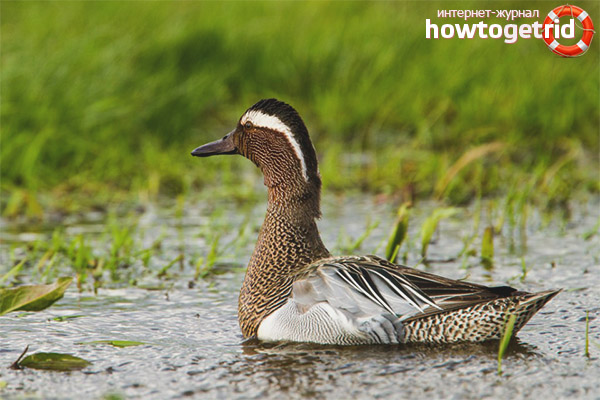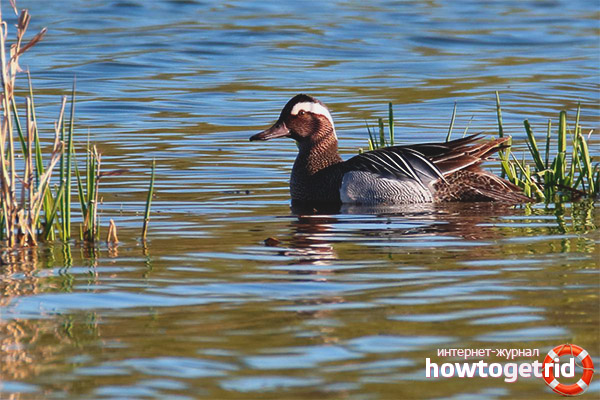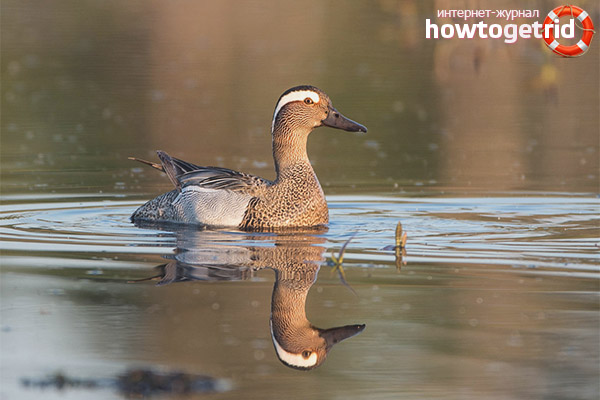The content of the article
The little teal crackling duck is known primarily for its unusual sonorous crackling, which is heard only during the mating season. But in their beauty, drakes are not inferior to other representatives of the duck family, but even superior. Their paired statuettes also decorate many dwellings, as it is believed that they bring love and prosperity to the house.
Duck travelers
Teal is a migratory species. They are able to withstand travel over vast distances, and spend the winter in southern Sahara, departing from the northern or northeastern regions of Russia. In the European part, they are rarely seen. For example, in Italy the population is up to 350 pairs, but wintering is not regular.
Having wintered in foreign lands, they return home later than all from the breed of ducks. Residents from the Western European zone arrive in March. But the birds of the northern and eastern regions cross their territories only in mid-May.
These miniature ducks find refuge on the banks of shallow ponds or marshes, rivers or lakes, so that it is necessarily covered with tall grass - mainly it should be sedge or reed. Thickets are needed in order to have a reliable place for shelter and comfortable nesting. Rarely, they nevertheless settle down by the sea or on arable land, although they belong to lake bird species.
These teal-crackers fly quickly, constantly maneuvering, and if you need to sit on the water surface, they do it gracefully, easily and quietly, without sound. Take-off occurs vertically, without take-off run. But, if this species is compared with that of a teal-whistle, it is noticeable that during take-off the body of the cracker is not so perpendicular to the surface of the earth. And they also have a poorly developed sense of caution, which is why they often pay with their lives.
Differences in appearance
The drake has a dark-colored head, and it has a wide snow-white brow strip, which is noticeable during the mating season. The eyes are brown. The chest is also brown, with a noticeable scaly pattern. White belly. The wings differ in gray-blue shades of plumage, with a “mirror” of gray-green color. They are without much shine, with a white border.
But the drakes have an amazing feature. When the mating season comes to an end, and it is usually summer time, the drakes begin to molt, all the elegant plumage disappears. And then they become like their girlfriends. Only the colored wings remain unchanged. The upper body looks solid and the bottom has dark streaks that look vague. And there are already no noticeable and attractive white stripes, turning into brown, but rather light. They are located in the same way as in females: they pass from the beak, crossing the eye zone.
Both sexes:
- in the chin and neck plumage is much lighter;
- the beak is expanded, has a dark gray color;
- a brown tail, there is also a white undertail, black speckles are visible on it;
- legs are gray.
The female is not so bright and attractive. Her plumage is brown, the marks are dark, there are bright spots. Gray-green shades of “mirror” do not shine. Chest and abdomen - soft white with dark spots. But goiter and sides stand out in red.
The young generation is difficult to distinguish from the formed female, but there are slight differences:
- barrel and chest are reddish;
- on the plumage of the abdomen, streaks of a contrasting color are noticeable.
The mating season and offspring
Teal maturation occurs unevenly.Some by the age of one year are able to have offspring, while others, being in the place of wintering, miss this time, putting off their first mating season. For these ducks, monogamy is a familiar way of life, and therefore they fly in pairs, and only during a mass flight create a small flock.
Returning after wintering, teal crackers strive to extend their genus, which means that their mating season begins. The main role is assigned to the drake. Usually everything happens in water bodies, where the birds are most comfortable.
The male begins to actively attract the female. It is difficult not to notice his efforts, since the gentleman, in addition to an unusual noticeable and very beautiful color, has ruffled plumage on the top of his head, shoulders are proudly protruded. Periodically, he lowers his beak into the water, throws his neck up, throwing his head back on his back or shaking it up and down. The less active ones raise the wing slightly, lowering their heads to the side. To achieve location, the drakes quickly flap their wings, rising above the water.
But the female in this crucial period is more restrained. She can shake her head slightly or begin to clean the feathers that are behind her wings.
It was during this period that the drake made such unusual sounds, which people associate with the crackling of a dried tree. But the sounds of the cracker are sharper and louder. Females have the same voices as other types of ducks - the usual voiced quack.
After the mating season, the time comes for laying eggs. This happens in April or May. Full clutch contains up to 12 eggs, but usually there are no more than 9. They have such colors - light fawn or yellowish brown.
Hatching lasts three weeks. When the chicks appear, they leave the nest very quickly, however, they begin to fly late - by the age of 40. These ducks can have only one clutch per year.
Variety in nutrition
The diet of a teal cracker is diverse. He prefers not only plant foods, but also animal foods. It feeds itself from the surface of the water, but can partially immerse itself in water, but it does not dive.
In the spring, when birds participate in mating games, create couples, raise offspring, and in summer mollusks are their favorite treat. But if it so happened that they were not in the place chosen for housing, ducks feed on those insects that usually live near water bodies. All sorts of larvae, leeches and worms also like him.
They also eat fry of fish, tadpoles, amphibians, which are at the stage of caviar, crustaceans.
In the spring, ducks eat plant vegetation from plants such as hornwort, and vallisneria from plant foods. In the rhizomes and the birch bark, they are primarily attracted to the seeds that they peck.
- sedges;
- mountaineer, avian;
- blackberry;
- rice;
- sorrel and others
Arriving on arable land, ducks collect seeds and grains here.
Recently, populations of these miniature defenseless ducks have noticeably decreased. The adverse environmental conditions and the poor environment in those places where birds are forced to winter are to blame. Hunters also destroy them, most of all for the sake of sports interest, proving themselves mastery. Often, whole masonry dies when the nest is in a meadow and grass mowing occurs.
Video: teal - whistle and crackler












Submit